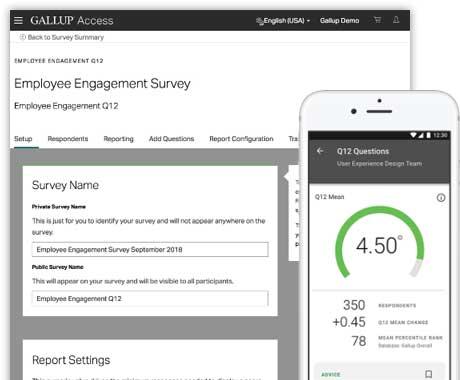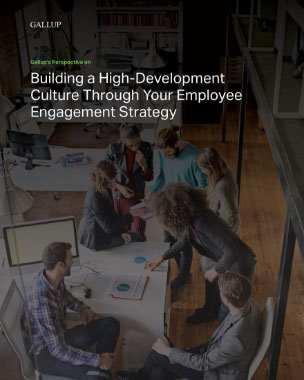Story Highlights
- Disengaged general managers cost restaurants too much
- Fixing engagement can fix problems with turnover and low organic growth
- Shifting organizational culture starts with engagement at the local level
Managers are far more engaged than the people they lead -- 61%, on average, vs. 34% in the U.S. overall.
Unless they're restaurant general managers (GMs).
A survey conducted by Gallup and TDn2K finds that GMs are about half as likely to be engaged as any other kind of manager. And because a manager's behavior cascades down to their team, disengaged GMs can suck the life out of every store they oversee -- and with it the profit out of the company's revenue -- every day.
In an industry with such high turnover and narrow margins, that's a disaster.
To address this, Gallup and TDn2K developed a model to measure and correct management engagement problems on a unit-level basis. The Restaurant Manager Connect gives leaders benchmarks and diagnoses the emotional factors that affect engagement, sales, traffic, turnover and guest satisfaction.
It's a vital resource for leaders -- fixing engagement problems is fundamental to fixing almost every other kind of issue, from recruitment to turnover to low organic growth. Over time, that effort will change an organization's culture for the better, but it starts with the individual store.
Based on the report findings, here are four necessary ingredients for addressing engagement:
1. Focus on engagement at the local and organizational levels.
Engagement initiatives are most effective when you weave employee engagement into performance expectations for your GMs and enable them to execute on those expectations. Managers and employees must feel empowered to make a significant difference in their immediate environment or engagement efforts will ring false.
Work with your GMs to identify barriers to engagement and opportunities to effect positive change.
It's possible that empowered GMs might go outside protocol for certain situations that aren't normally accounted for in the budget -- like authorizing a few team members to work extra hours for a last-minute party, or a paid day off for an employee's family emergency. But overall, empowering GMs to fix their own problems can fix some of their engagement issues -- and the store's -- at the same time.
True, leaders can find it difficult to run a clean cost/benefit analysis on things like a cook's paid day off -- but you should bear in mind the cost of deflating GMs who are trying to improve performance. Work with your GMs to identify barriers to engagement and opportunities to effect positive change.
Connect with your store-level employees, too. They're intimately familiar with the company's processes, systems, products and customers. They're also experts on themselves and their teams. They'll have valuable insights that will help the brand deliver improved performance, business innovation and better workplace experiences.
Now, more than ever, leaders, GMs and shift managers can create change -- and customers want it. But, it begins in the stores, and it's always individual.
2. Use the right employee engagement survey.
Businesses often make the mistake of collecting data that are irrelevant or impossible to act on -- things like parking lot access or tipping out the bussers. If you can't change it, don't ask about it. Useful survey data, on the other hand, are always team-level, specific, relevant and actionable for any team anywhere in the organization. And data are only worth the money if they're proven to influence key performance indicators (KPIs) -- and engagement is one of the most important KPIs you have.
The right questions achieve data that show you where disengagement is gaining steam -- where people lack the materials and equipment they need to do their jobs right, for example -- and where engagement is flourishing. Either way, the data tell leaders what GMs need to sustain high store-level performance and engagement.
That's a valuable commodity in a low-margin business. A recent Gallup meta-analysis shows that teams in the top quartile of engagement show 41% lower absenteeism, 24% less turnover in high-turnover organizations like restaurants, 28% less shrinkage, 70% fewer safety incidents, 40% fewer product quality defects, 10% higher customer ratings, 17% higher productivity, 20% higher sales, and 21% higher profitability, compared with bottom-quartile teams. And the earnings-per-share growth of companies that are the best at engaging their employees is more than four times that of their competitors.
So leaders, your employee engagement rate should be a KPI that's just as important as SSS or EBITDA -- or a predictive metric of both -- because engagement fundamentally affects profit.
The Gallup Q12 is a scientifically valid metric with a framework for developing engagement. Be mindful, though, that the worst thing restaurants can do is ask their people for feedback and then never share the results or what leadership is going to do to address it. When a company asks its employees for their opinions, those employees expect action to follow.
3. Define engagement goals in realistic, everyday terms.
Managers must describe what success looks like to their teams using powerful descriptions and emotive language.
- "We're succeeding when team huddles before open make you feel like a runner just before the gun goes off."
- "You know we're succeeding when your guests' responses make you happy that you came to work."
- "We know we're succeeding when we're still energized at close, even though we're worn out."
Those examples all hinge on emotion -- which is the most powerful motivator humans have. For team members to feel it, managers have to describe it. GMs who link emotion to engagement will get better performance.
Be sure to explain to your GMs that engagement isn't offered, it's generated -- during an informal check-in, the morning huddle, team meetings and down periods. If you make engagement emotional, GMs can pass your understanding of engagement along to their teams. That's how they weave engagement into the store's DNA. For engagement to have impact, it can't be an "extra" or a pleasantry if there's time for it. It must be part of every GM's life, embedded in the ongoing conversation and the life of the store.
4. Select the right managers and hold them accountable.
The most important thing you can do is hire talented managers. Managers are responsible for 70% of the variance in employee engagement. The role is unique, with distinct functional demands that require a specific talent set, but all great managers care about their people's success. They seek to understand each person's strengths and provide employees with every opportunity to use theirs. Great managers empower their employees, recognize and value their contributions, and actively seek their ideas and opinions.
GMs who link emotion to engagement will get better performance.
Now is the time to start looking for stars to fill GM positions in the future. It is not okay to name someone manager because they were "next in line" or a great server or bartender. Managers should be held accountable for their team's engagement and some people are just not up to the task. The most successful managers, however, view the Q12 assessment as a tool for great managing, not just a set of questions for measuring.
Help your GMs use those tools to the utmost. Managers hold the most important roles in your business and they need to show they can engage and lead people. Selecting people who have this talent is the first, best way to improve your business outcomes.
TDn2K's 2019 Recruiting and Turnover survey results showed that the average cost of turnover per GM for restaurants is $13,996 -- and turnover is up, the survey shows, to 39% for all managers, 26% for GMs. Those figures also don't include the expense of disengaged GMs, but you can see the price of disengagement in every customer who doesn't come back, every server who doesn't show up, every supplier who blows you off, every meal that goes out wrong and winds up in the trash.
Those profit leaks add up. An engaged GM wouldn't stand for them and you shouldn't either.
The good news is, you don't have to. But you do have to hire talented GMs who can engage their teams. The money spent identifying and hiring them is nothing compared with the expense of a disengaged and disengaging GM -- and far less than the profit potential that comes with a great GM.
Cut the cost of disengagement:
- Use Restaurant Manager Connect, a tool from TDn2K and Gallup, to measure your managers' engagement and compare it against competitive benchmarks.
- Subscribe to Gallup Access for customer and employee data and insights that get results.






